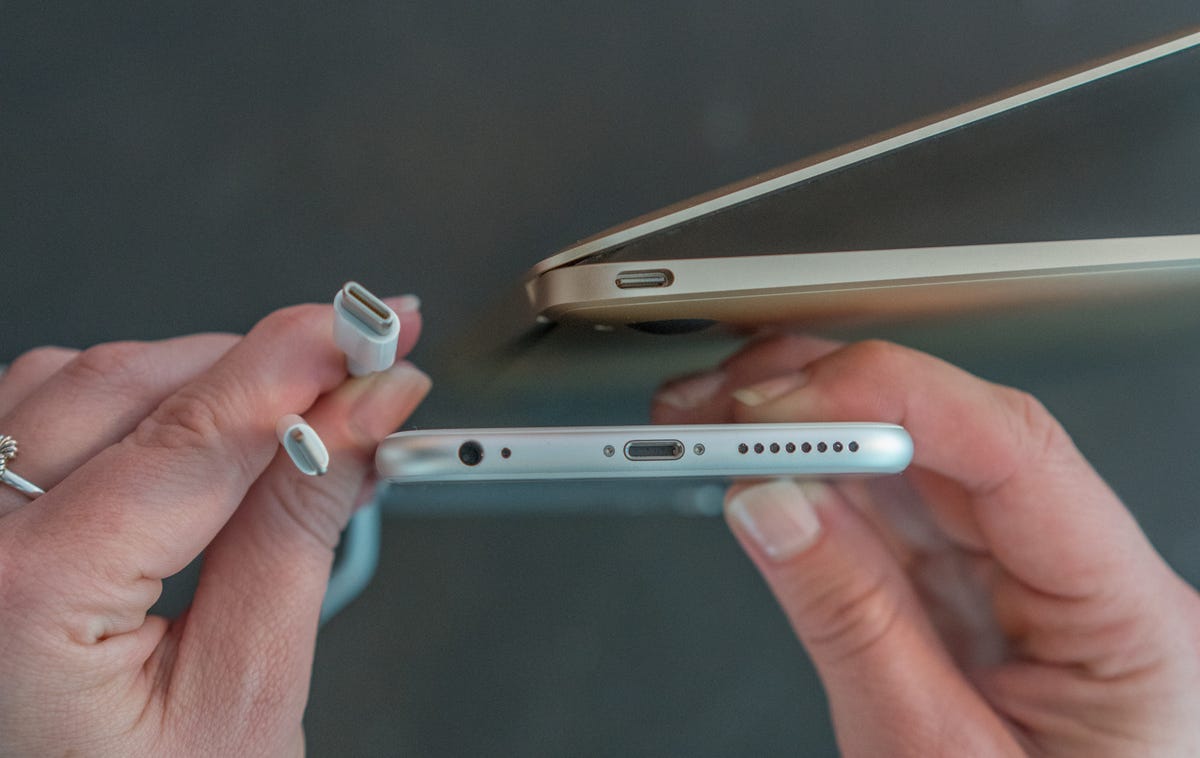 Enlarge Image
Enlarge ImageCNET
Microsoft’s new smartphones have it. Google’s new tablet has it. Even the upstart OnePlus 2 is on board. Apple, at least when it comes to its new accessories, would rather not commit.
The object of affection outside Apple is USB Type-C, which is quickly becoming the go-to connection port for this year’s top-shelf devices, bringing the new charging standard tantalizingly close to becoming universal for your household’s smartphones, tablets and laptops.
And what’s not to love about this blandly named flavor of USB? It’s one port that can be used for charging, running video to a TV and downloading files. It’s also reversible so folks don’t have to fumble to orient cords properly. With lots of devices using that standard, people won’t need to fill a drawer with different cables; they’ll just need a USB-C cord or two for PCs, phones and tablets.
Yet things are rarely simple in the tech world, especially when Apple is involved. The Cupertino, California, tech giant on Tuesday unveiled a new keyboard, mouse and trackpad that charge using Apple’s proprietary Lightning port, the same type found on the iPhone and iPad. For now, at least, that dashes the hope that Apple may move to a standard everyone else is slowly embracing.
People can be forgiven for thinking Apple, the most valuable company worldwide, may shift away from Lightning to USB-C: In March it introduced a new MacBook laptop that uses a headphone jack and just one port, which happens to be USB-C. But with the new accessories supporting Lightning, it now seems less likely Apple will make such a change anytime soon, forcing many users to keep swapping different cords.
“I’d be shocked if they went that way with the iPad and the iPhone,” said Mike Feibus, principal analyst at TechKnowledge Strategies, of Apple switching to USB-C. “Their typical MO [modus operandi] is to find something off to the side … and they’re the only ones that support it.”
Say hello to Apple’s new Magic Keyboard, Magic Mouse 2 and Magic Trackpad 2 for the Mac (pictures)






+13 more
Tech schisms can be a real pain for customers. They have a harder time switching between Apple products and those in the rest of the world, and that’s often led Apple-specific peripherals to be specialty items instead of mainstream products.
To Apple, a Lightning port may make sense since some users tend to leave such a cord dangling from their Macs already, presumably after syncing or charging their iPhone.
Apple has a history of going its own way when it comes to plugging things into its computing devices. In the 1990s, it embraced the SCSI interface for scanners and external storage devices for its Macs, a standard rarely used in the Windows world. And first with FireWire and now with Thunderbolt, Apple has included interfaces that offered higher speeds than USB but that were rarely found elsewhere.
In the smartphone era, Apple-only standards aren’t so inconvenient: iPhones ship in such large numbers compared to competing products that it’s much easier to find accessories like speaker docks, cases and even Lightning-connected digital cameras .
“There isn’t much good rationale for forcing a change on its user base without much benefit,” Current Analysis analyst Avi Greengart said, noting how Apple users already had to go through an annoying transition from a bigger, 30-pin connector to Lightning in 2012.


Now playing:
Watch this:
Meet Apple’s new keyboard, trackpad and mouse
2:27
And sometimes Apple paves the way for others: Its first Macs used 3.5-inch floppy disks that wouldn’t work with competing computers’ 5.25-inch disk drives, but in a few years, the rest of the industry embraced the smaller disks. Lightning brought a more compact design and reversibility three years before USB-C.
Because Apple has been willing to use technology that’s off the beaten track, it is likely to stick with Lightning, Feibus said. That technology offers many of the same benefits as USB-C, such as a reversible cord, while also helping keep customers in the Apple family of products.
Oh, and it doesn’t hurt that Apple gets a fee from all licensed Lightning cables.
“Don’t underestimate the value of cable sales,” Feibus said. “It’s a big plus.”
But that dream of walking into an airport and using a single cable to charge anything? It seems further away than ever.
Correction on October 14 at 5:50 a.m. PT: Fixed a reference to Apple’s support for USB. Apple began supporting the standard in 1998.



